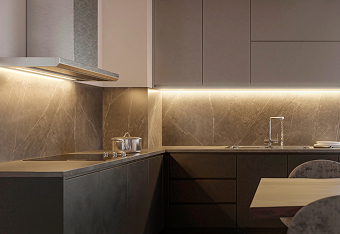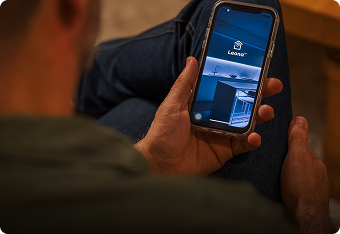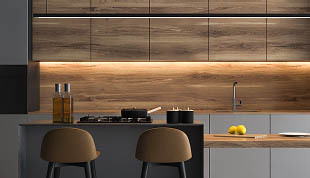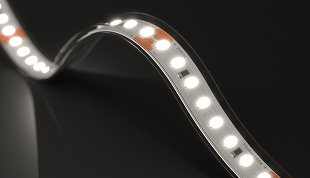How to Design and Install LED Strip Lighting Behind a Mirror: A Step-By-Step Guide
Learn how to choose and install LED strip lighting behind a mirror with our step-by-step guide. Choose the perfect LED lighting for your desired ambiance and enhance the look of your home or business.
We install mirrors all over our homes and businesses for functional and stylistic reasons. Mirrors are great visual tools to open up spaces, add depth to a room, and check ourselves out. Designing spaces with beautifully backlit mirrors is one of the fastest-growing interior design trends, and we will show you the main steps on how to achieve this. Installing LED lighting behind the mirror is an excellent way to enhance the look, add an energetic or relaxing mood, and increase the usability of the space and the mirror.
Your installation will vary depending on the mirror, the shape of the mirror, the offset of the mirror from the wall, and the LED strip light used.
In this article, we will guide you through all the steps of designing and installing your LED Strip Lighting Behind Your Mirror:
Quick links to article sections:
1. Project Planning: Choose Your Backlit Mirror Type
Before starting your project, take note of these important considerations:
Mirror Type:
There are many types of mirrors, from large wooden-framed mirrors to thin round mirrors. You can also find floating mirrors and mirrors that are part of a vanity or dresser. Backlit mirrors require sufficient space behind the mirror, so make sure your mirror has space behind it for the lighting to illuminate the wall. If you do not have a floating mirror, you can purchase hardware to install it off the wall. You can also purchase spacers
Mirror Installation
When it comes to installing a mirror, several factors come into play. Ask yourself these questions:
- Does the mirror have a base?
- Is it attached to a cabinet or dresser?
- Is it attached to the wall by a 2” wood piece?
- Does it adhere directly to the drywall?
- Is there enough space behind the mirror to place the lights?
By considering these aspects, you'll be better prepared to plan and execute a successful mirror installation while ensuring safety and functionality.
Location
The location plays a vital role when installing a mirror. Consider the following questions:
-
Where is the mirror located? Is it in the bathroom, bedroom, living room, dressing room, entryway, dining room, or closet?
-
What is the function of the mirror? Understanding its purpose helps determine the desired lighting and ambiance.
-
How often is it used? Considering the frequency of use helps ensure durability and appropriate lighting choices.
You can transform any room into a visually stunning and functional oasis by considering your mirror's location, function, and usage frequency. Let your creativity shine through as you plan your mirror installation.
Purpose of the Lighting
By exploring the reasons for wanting lighting in a specific area and behind a mirror, we can better align the lighting solution with your unique needs and create a captivating atmosphere. Knowing your lighting goals will guide you in selecting the most suitable options for you:
-
Why do you want lighting in this area and behind this mirror?
-
Are you trying to add more light in the area for task lighting or something specific?
-
Do you want to create an energetic space with vibrant colors and effects?
-
Add ambiance with accent lighting?
-
Do you see yourself better in the mirror?
-
Balance out the space without the need for more furniture or large lighting fixtures.
-
Create a nightlight effect that’s easy on the eyes.
-
Entryway lighting for when you come in and out of the home?
Think about your intentions and what you want the lighting to accomplish. Your mirror lighting can also accomplish different purposes at the same time.
Here Are a Few Examples You Might Think Of
-
“My master bedroom’s private bathroom mirror is large and rectangular and is offset from the wall by 3” above two sinks. We use this mirror every day and night for grooming and dressing. My bathroom is not very bright, and even with our downlights, it is hard to see ourselves in the mirror. I want to install lighting behind the mirror to create a beautiful and bright indirect light so we can see ourselves better and use the light as the main lighting source in the bathroom.”
2. “In our living room, we have a medium-sized floating mirror attached to our embedded entertainment center. It’s in the main area for guests in our home, so I added the mirror to create space in the area. I want to be able to add ambient accent lighting to the area to highlight the natural wood tones of the entertainment center and balance out the lighting that is on the other side of the living room. Whenever we watch movies or spend time with our guests, I want the entire living room to glow. It would be fun to use a remote control or my phone to control the lighting.”
3. “I have a medium-sized rectangular mirror by my front door. I use it every day when leaving the house as a visual check to see if I have everything. I feel I am losing the function of the space in the evening when I come home. I would like to add gentle white lighting to the back of the mirror and have a timer or motion sensor that comes on when I arrive home. By doing so, I will avoid fumbling for the lights when I enter the house. It will also add a lot of style to this area of my house.”
2. Choosing Your LED Strip Light
Once you are clear on the intent and location of the space you want to light, you can choose your LED lighting types. There are many output options, brightness levels, and types of LED strip lights.
Each type can create a specific ambiance or effect. Check out the selection below to find the ideal choice that suits your preferences and desired mood:
Static White:
Static white LED strip lights emit a constant, unchanging light at a single-color temperature. Static white is ideal where a consistent color temperature is desired. For home use, the most popular color temperatures are 2700K, 3000K, and 4000K.
-
Static White - Plug and Play Strip Light Kit: Offers options for light output, color temperature, strip size, and control method.
- Static White - Hardwired Wall Dimmer Pro Strip Light Kit: Includes all necessary components for a seamless installation.
Dynamic White Light:
Tunable white lighting technology enables you to control the color temperature from a single light source. You can select the precise hue of white light that best meets your needs anywhere between warm white and cool white. You can control these lights using a dimmer switch, a remote control, or even a smartphone app.
You can, for example, select a warm, cozy light on your bedside dresser mirror for a relaxing evening, or a bright and cool light for a focused work environment next to your desk. The possibilities for creating the ideal ambiance in your home are nearly limitless with tunable white LED strip lights.
-
Tunable White Strip Lights: 2700K-5000K white selectable.
- Dim-to-Warm Strip Lights: 1800K-3000K, where 100% brightness starts at 3000K and the color temperature drops as you dim the light, similar to incandescent light.
RGB Color Changing:
RGB color-changing lighting gives you full control of any color you desire. RGB means Red, Green, and Blue because the LEDs contain three chips, and each chip lights one of these colors. They are blended to create millions of colors or dynamic modes by pairing them with a controller. This way, you can create almost any color you can imagine. In dynamic areas, like your bedroom, living room, children's room, dens, and basement bar, RGB color-changing lighting is a great fit.
There are many types of RGB lighting you can purchase. Here are a few terms to get them straight.
-
RGB: Only RGB LEDs populate the strip. There are millions of color options and dynamic modes available.
-
RGBW: A mix of RGB and White LEDs on the strip. Millions of colors and a single shade of white.
-
RGB and Tunable White: Offers millions of colors and Tunable White Light (2400K - 6500K). Choose from any color or any shade of white and get complete lighting ambiance control at your fingertips.
- Digital Pixel RGB: Also called Pixel LED strips, these have individually controllable segments, so you can have many different colors throughout the strip at the same time. This can give scrolling, chasing, or other scenes.
Brightness:
The LED strip lights should provide enough brightness for your desired ambiance or the task you want to accomplish. Consider the room size, ceiling height, and the type of light you want. Brightness is measured in Lumens. When comparing LEDs, make sure you know how many lumens per foot they emit.
As a general guideline, you can expect to need approximately:
-
80-100 lumens per foot for low accent lighting.
-
150-300 lumens per foot for brighter accents and low ambient lighting.
-
300-400 lumens per foot for higher-medium ambient or medium task lighting.
-
350-500 lumens per foot for ambient or task lighting.
-
700+ lumens per foot if it is a large commercial bathroom with high ceilings.
Color Temperature:
If using Static White or Tunable Dynamic White, choose the right color temperature for your room based on the desired atmosphere. Consider what other lighting you have or want in the area, the natural colors of the building materials, and paints. You do not want multiple color temperatures in one space. Consistency is key.
-
Ultra-Warm White (1800K-2500K) Candlelight-like. Creates a warm and cozy atmosphere, evoking feelings of intimacy, relaxation, and comfort.
-
Warm White (2700K-3000K) for a warm and intimate atmosphere.
-
Natural White (4000K) for a bright and functional look.
-
Cool White (5000K) for a crisp and modern look.
Color Rendering Index (CRI):
A Color Rendering Index (CRI) measures how accurately a light source renders the colors of objects compared to natural sunlight. It rates the quality of light on a scale of 0 to 100. In applications where color accuracy is crucial, a high CRI is important.
We highly recommend a high CRI (90 or higher) for mirror lighting when using white lighting. Low CRI makes colors dull and hard to distinguish from each other.
Why Do You Need High CRI Lighting for Mirrors?
Mirrors highlight an intimate space where we come face-to-face with ourselves in our barest and best forms. When getting ready, applying makeup, or trying on clothing, it's important that we see colors in their true form. It also makes the paint, tiles, countertops, and art in your bathroom pop in full-vibrant color.
LED strip light manufacturers should always list the CRI under their product specifications when selling white LEDs, so, when you're picking white lighting, make sure it has a CRI of over 90. This way, you'll get the best quality and true-to-life colors. Our Flexfire LEDs are known for high CRI LED strip lighting.
LED IP Rating (IP)
The term "LED IP rating" refers to the level of protection provided by the LED strip light against the intrusion of solid objects (such as dust) and liquids (such as water). IP indicates the level of protection offered by an electrical device. When using LED strip lights in bathrooms, it is important to ensure that they are waterproof to prevent any damage caused by water exposure.
If your mirror will be placed in bathrooms, make sure to get a waterproof LED strip. How can you do it? Check that your LED strip lights have an IP65 rating. By selecting LED strip lights with an IP65 rating, you can ensure that they are adequately protected against both dust and water, making them suitable for bathroom environments.
3. Additional Considerations: How Do I Want to Control My Lights?
When it comes to controlling your lights, there are several options available to suit your preferences and needs. You can choose on/off switches for manual control, wireless controllers for convenient operation, or occupancy sensors for automated lighting. If you prefer integrated control, home automation systems offer a comprehensive solution. For hands-free commands, you can opt for voice-controlled devices like Alexa or Google Assistant. Smartphone apps provide remote access and customization, allowing you to control your lights from anywhere. Select the option that best fits your lifestyle and enjoy effortless control over your lighting. Whether you prefer manual control, automation, hands-free commands, or remote access, there is a control method that suits your preferences.
-
Leona® Pro Smart Home Controller: Adjusts colors and brightness levels to relax, work, or play; compatible with Google Home and Amazon Alexa smart home speakers.
-
MiniXR Remote Control for RGB Strip Lights: Provides various lighting effects such as dimming, strobing, fading, flashing, and speed adjustment.
-
Leviton 300W Decora Smart 2nd Gen Wi-Fi Dimmer: Allows you to control your LED strip lights remotely using Wi-Fi and the free My Leviton app
Explore more options here and discover the convenience and flexibility they bring to managing your mirror lights.
4. Pre-installation
Before installing LED strip lighting behind a mirror, there are a few things to consider.
-
Make sure you have the correct lights, power supplies, controllers, connectors, and other necessary tools and equipment.
-
If you are hardwiring your power supply to a dimmer and drive (working with AC), turn off the power to that section of the home on the breaker panel.
We always recommend hiring a licensed electrician or tradesman to complete any installation working with high voltage. -
Find the correct placement of LED strip lighting that does not interfere with the mirror's functionality. There are two ways to install the lighting. We recommend taking a strip of light, turning it on manually, and placing it behind the mirror. Test different locations along the back of the mirror until you achieve the desired look.
One is where the adhesive tape is stuck directly to the mirror and pointed toward the wall.
The second way is to place the LED strip directly onto the cabinet where the mirror is installed, providing indirect lighting.
4. There shouldn't be any objects or obstacles in your way when you're installing the LED strip lighting. Having a clear space allows for a smooth and hassle-free installation process. So, make sure to ensure that the area behind the mirror is free from any clutter or obstructions before you begin installing the lighting.
5. Lights Installation
Before you start the installation, it's important to gather all the necessary items. Here are the key components you will need for a successful installation:
LED Strip Lights
Power Supply
Controller
Connectors (if you prefer no to solder)
Scissors
Cleaning Supplies
We recommend you gather these items beforehand to make the process seamless.
Step 1: Determine the Length of the LED Strip and Cut It to Length
To get started, take measurements of the mirror's length and cut the LED strip lighting accordingly. Cut the strip at the designated cut points. This ensures that the lighting fits perfectly along the mirror and avoids unnecessary damage or irregularities.
Draw a diagram of how you will attach the LEDs to the mirror. We do not recommend pinching or bunching up the PCB around corners like other articles out there would recommend. When using a quality product, We recommend cutting the strip and installing solderless connectors between the sections or soldering the LED strip to the wires between each section.
Before installing and sticking any lights to your mirror, attach and test them all.
Step 2: Attach the LED Strip Lights to the Mirror
We recommend installing the strips 3 to 4 inches from the edges of the mirror. Peel off the adhesive backing from the LED strip lighting and attach it to the back of the mirror. Be sure to press down firmly to ensure a strong hold.
Step 3: Connect the LED Strip to the Power Supply and Your Control System
Attach the connectors to both ends of the LED strip lights and then connect them to the power supply. Make sure that the power supply is plugged into a power outlet.
Step 4: Test the LED Strip Lights Again
Turn on the power supply and test the LED strip lights to ensure they are working correctly. If the lights are not working, check the connections and try again.
Step 5: Conceal the Wiring
Use wire clips or cable ties to secure the wiring to the back of the mirror or the wall to prevent any loose or hanging wires.
Step 6: Clean the Mirror and Enjoy Your Lights
Ensure that the mirror is clean and free from any smudges or dirt. This will ensure that the LED strip lighting is visible and enhances the look of the mirror.
At Flexfire LEDs, we are committed to providing our customers with high-quality LED lighting solutions that are not only functional but also visually appealing. With a wide range of LED strip lights available, we can help you choose the perfect lighting for your space. Our dedicated design team can help you build your project for free! Whether you are looking for task lighting, accent lighting, or ambient lighting, we have the right product for you. With our expert guidance, you can achieve the perfect lighting design behind your mirror and elevate the look and feel of your space.
Contact our project design team here to get your next LED strip lighting project started and experience the difference for yourself.
Frequently Asked Questions
Q: What are the benefits of installing LED strip lighting behind a mirror?
A: Backlit mirrors can visually open up a space, add depth to a room, and create a beautiful and bright indirect light. LED strip lighting behind a mirror can enhance the look, add an energetic or relaxing mood, and increase the usability of your space.
Q: What types of mirrors are suitable for backlit LED strip lighting?
A: Backlit mirrors require sufficient space behind the mirror. You will need a mirror with enough space behind it for the lighting to illuminate the wall. You have a wide range of mirror options to choose from, each with its own unique features and style. Whether you prefer a large wooden-framed mirror, a round wall mirror, a floating mirror, or a mirror integrated into a vanity or dresser, there are plenty of choices available. Consider your preferences and the overall aesthetic you want to achieve when selecting the perfect mirror for your space.
Q: What factors should I consider when choosing my LED strip lighting?
A: Consider the mirror type, mirror installation, location, intended lighting purpose, brightness, color temperature, and color rendering index. Each type of LED strip light has the ability to create a specific ambiance or effect, and different lighting options should be chosen based on the desired atmosphere of the space.
Q: Is it safe to install LED strip lighting myself?
A: We always recommend hiring a licensed electrician or tradesman to complete any installation working with high voltage. However, if you feel comfortable working with electrical components and have experience installing lights, you can do it yourself. Take the proper safety precautions and follow the instructions carefully.
Q: What are some ways to control my LED strip lighting?
A: There are many options, such as simple on/off switches, wireless controllers, occupancy sensors, home automation, Google Assistant, Amazon Alexa voice-controlled, or smartphone apps. The type of controller you choose will depend on your personal preference and the intended use of the lighting.








